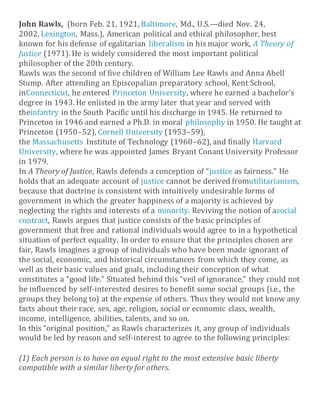
John rawls
- 1. John Rawls, (born Feb. 21, 1921, Baltimore, Md., U.S.—died Nov. 24, 2002, Lexington, Mass.), American political and ethical philosopher, best known for his defense of egalitarian liberalism in his major work, A Theory of Justice (1971). He is widely considered the most important political philosopher of the 20th century. Rawls was the second of five children of William Lee Rawls and Anna Abell Stump. After attending an Episcopalian preparatory school, Kent School, inConnecticut, he entered Princeton University, where he earned a bachelor’s degree in 1943. He enlisted in the army later that year and served with theinfantry in the South Pacific until his discharge in 1945. He returned to Princeton in 1946 and earned a Ph.D. in moral philosophy in 1950. He taught at Princeton (1950–52), Cornell University (1953–59), the Massachusetts Institute of Technology (1960–62), and finally Harvard University, where he was appointed James Bryant Conant University Professor in 1979. In A Theory of Justice, Rawls defends a conception of “justice as fairness.” He holds that an adequate account of justice cannot be derived fromutilitarianism, because that doctrine is consistent with intuitively undesirable forms of government in which the greater happiness of a majority is achieved by neglecting the rights and interests of a minority. Reviving the notion of asocial contract, Rawls argues that justice consists of the basic principles of government that free and rational individuals would agree to in a hypothetical situation of perfect equality. In order to ensure that the principles chosen are fair, Rawls imagines a group of individuals who have been made ignorant of the social, economic, and historical circumstances from which they come, as well as their basic values and goals, including their conception of what constitutes a “good life.” Situated behind this “veil of ignorance,” they could not be influenced by self-interested desires to benefit some social groups (i.e., the groups they belong to) at the expense of others. Thus they would not know any facts about their race, sex, age, religion, social or economic class, wealth, income, intelligence, abilities, talents, and so on. In this “original position,” as Rawls characterizes it, any group of individuals would be led by reason and self-interest to agree to the following principles: (1) Each person is to have an equal right to the most extensive basic liberty compatible with a similar liberty for others.
- 2. (2) Social and economic inequalities are to be arranged so that they are both (a) to the greatest benefit of the least advantaged and (b) attached to offices and positions open to all under conditions of fair equality of opportunity. The “basic liberty” mentioned in principle 1 comprises most of the rights and liberties traditionally associated with liberalism and democracy: freedom of thought and conscience, freedom of association, the right to representative government, the right to form and join political parties, the right to personal property, and the rights and liberties necessary to secure the rule of law. Economic rights and liberties, such as freedom of contract or the right to own means of production, are not among the basic liberties as Rawls construes them. Basic liberties cannot be infringed under any circumstances, even if doing so would increase the aggregate welfare, improve economic efficiency, or augment the income of the poor. Clause b of principle 2 provides that everyone has a fair and equal opportunity to compete for desirable public or private offices and positions. This entails that society must provide all citizens with the basic means necessary to participate in such competition, including appropriate education and health care. Clause a of principle 2 is known as the “difference principle”: it requires that any unequal distribution of wealth and income be such that those who are worst off are better off than they would be under any other distribution consistent with principle 1, including an equal distribution. (Rawls holds that some inequality of wealth and income is probably necessary in order to maintain high levels of productivity.) In Rawls’s view, Soviet-style communism is unjust because it is incompatible with most basic liberties and because it does not provide everyone with a fair and equal opportunity to obtain desirable offices and positions. Pure laissez- faire capitalism is also unjust, because it tends to produce an unjust distribution of wealth and income (concentrated in the hands of a few), which in turn effectively deprives some (if not most) citizens of the basic means necessary to compete fairly for desirable offices and positions. A just society, according to Rawls, would be a “property-owning democracy” in which ownership of the means of production is widely distributed and those who are worst off are prosperous enough to be economically independent. Although Rawls generally avoided discussion of specific political arrangements, his work is widely interpreted as providing a philosophical foundation for egalitarian liberalism as imperfectly manifested in the modern capitalist welfare state or in a market-oriented social democracy.
- 3. In a later work, Political Liberalism (1993), Rawls revised the argument for the two principles of justice by construing the contracting individuals as representatives of conflicting comprehensive worldviews in a pluralistic democracy. Rawls also wrote works on international justice and human rights and on the history of moral and political philosophy. The nature of utilitarianism Utilitarianism is an effort to provide an answer to the practical question “What ought a person to do?” The answer is that a person ought to act so as to produce the best consequences possible. Social contract,in political philosophy,an actual or hypothetical compact, or agreement, between the ruled and their rulers,definingtherightsand dutiesof each. In primeval times, accordingto the theory,individualswereborn into an anarchicstate of nature,which was happy or unhappy accordingto the particular version.They then, by exercisingnatural reason, formed a society (and a government)by means of acontract among themselves.